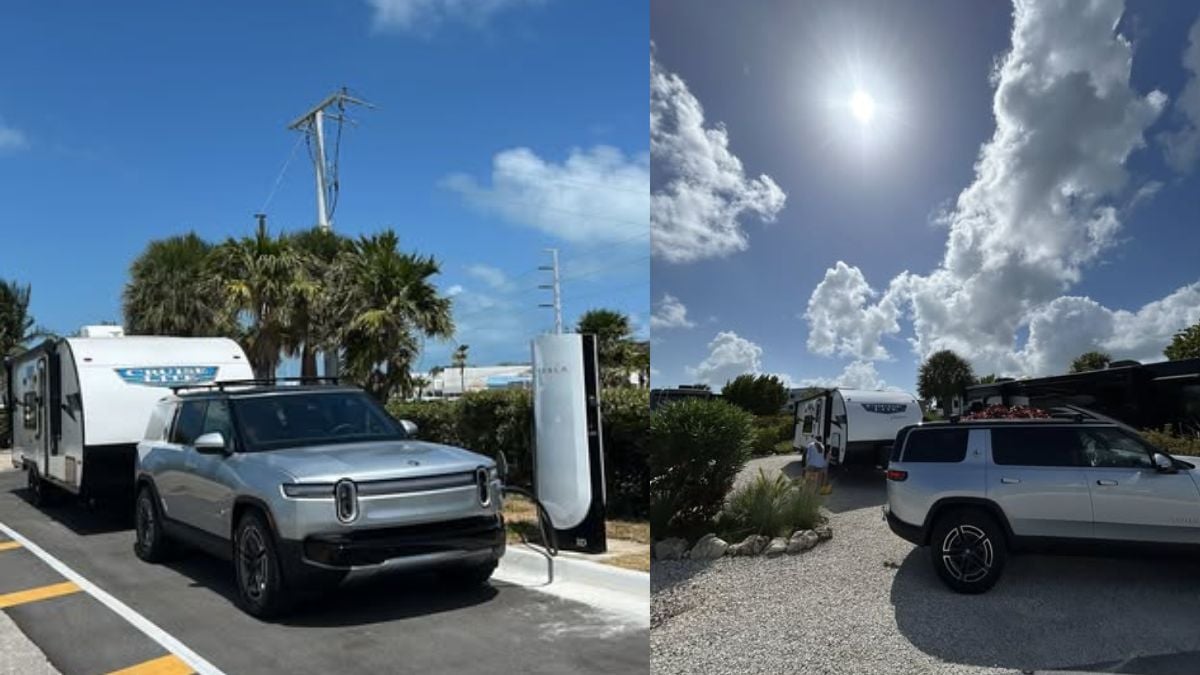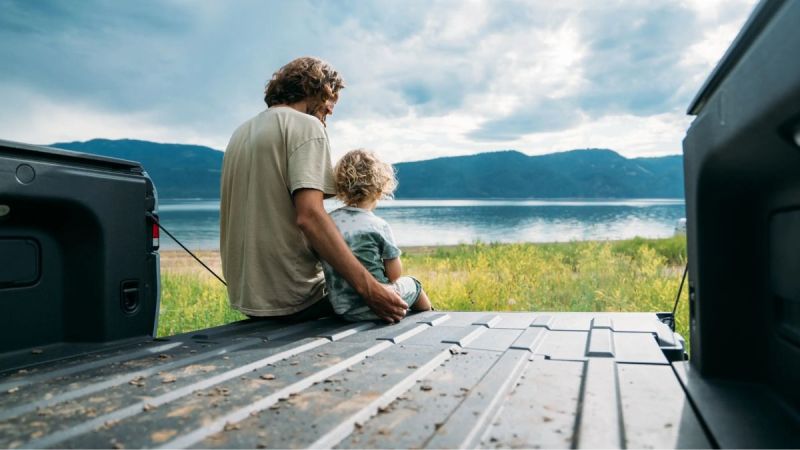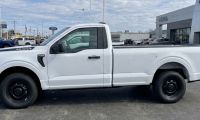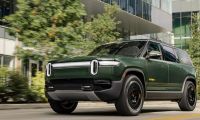I was scrolling through the “RIVIAN Electric Vehicles Discussion” group on Facebook when a post from Jose Antonio Herrera caught my attention, and not just because it had a photo of a Rivian hitched up to a beefy RV. It was what he said that really made me stop and read.
Jose had just taken his Rivian R1S on its first RV trip. He towed a 5,000-pound trailer, learned a few key lessons about range and charging, and even discovered what might be the camper-friendly Supercharger on the map. Here’s what he posted: “First RV trip with the Rivian, range dropped to about 130 miles while towing a 5,000lb trailer. Most charging stations required unhooking the trailer, except for one perfect pull-through Supercharger in Marathon Key. Towing mode worked flawlessly, with strong torque and acceleration that made it easy to forget we were even pulling something. At the campsite, we used a 50A outlet to charge the Rivian overnight while keeping the RV on 30A, with charging speeds similar to home.”
It’s a short post, but it says a lot, and it’s basically a cheat code for anyone thinking of towing with their Rivian for the first time. Let’s break it down.
130 Miles of Range While Towing? Yep, That’s Pretty Normal
Dropping from 260 miles to 130 sounds like a punch to the gut at first, but in the EV world, that’s just what happens when you hook up a trailer. Wind resistance, rolling weight, elevation, it all adds up fast. But what stood out is that Jose’s range was consistent and predictable. That makes planning a lot easier.
Other Rivian owners have reported similar numbers, and if you’re wondering whether the trip is still worth it despite the drop, the answer seems to be a confident yes. One R1S owner even did a long haul to Las Vegas and came away impressed by how comfortable and capable the SUV felt.
So while it’s not a surprise that towing cuts range in half, it’s comforting to see real-world confirmation of what you can expect, and that it doesn’t ruin the trip.
Towing Mode: A Total Game-Changer
Jose mentioned that Rivian’s towing mode “worked flawlessly.” That might sound like a generic compliment, but if you’ve ever towed a trailer with a vehicle not designed to do it, you know how big of a deal that is.
The Rivian automatically detects the trailer’s weight, adjusts acceleration, tweaks regen braking, and stabilizes the whole setup. It doesn’t feel floaty or unsure. In Jose’s words, the torque and acceleration were so good, it was “easy to forget we were even pulling something.”
That kind of experience shows why more EV owners are starting to test their vehicles in situations previously reserved for diesel trucks. And if you’re curious how the Rivian compares to gas SUVs from a cost and comfort standpoint, there’s a great breakdown here.
Charging with a Trailer Is Still the Hard Part
Here’s where things get tricky. Jose said most chargers along the way required unhooking the trailer to access the stalls, something that adds time and stress when you just want a quick stop. It’s one of the biggest hurdles for people trying to road trip or tow with an EV.
But then, there was a surprise: a Tesla Supercharger in Marathon Key that was actually pull-through. Jose called it “perfect,” and honestly, that might not even be strong enough of a word. A pull-through charger when you’re towing is gold.
Pull-through setups like that are extremely rare right now, but they need to become the norm. Especially as more people take trucks like the R1T and R1S on cross-country trips with trailers in tow. Otherwise, it’s unhook-and-hoped every time.
RV Campsites Save the Day (and the Battery)
Here’s the real pro tip: you don’t need to find a fancy fast charger when you’re towing if you’re staying at a campground. Jose used a 50-amp outlet at the campsite to charge the Rivian overnight. The RV plugged into the standard 30A outlet, and both were powered up by morning. No waiting around, no stress, just plug in and relax.
If you haven’t tried this yet, it’s kind of brilliant. EVs love stable, overnight charging. And RV sites are built for big loads and extended stays.
In the comments of Jose’s post, another member named Kent chimed in with a great warning for anyone planning to use a 30-amp plug instead: “You can also charge from a 30 amp. Just be sure to buy an EV adapter rather than an RV adapter. And be sure to lower your amperage to 24. The Rivian will not detect the lower amperage and you can melt the adapter (so I've learned).”
That last bit? Critical. This is the kind of firsthand knowledge you don’t get from a user manual.

Towing with an EV Is All About Planning Smart
Jose’s trip shows what’s possible when you combine a capable EV with smart planning. Yeah, range drops. And yeah, some chargers are a pain. But with towing mode handling the drive and campsite charging making the stops easy, the whole experience looks way less intimidating than it sounds.
Still, planning is key. You’ve got to map your route, check charging access, and know where your backup plans are. Whether it’s a charging mystery that leaves a Rivian unplugged overnight or a sudden post-purchase failure, it’s clear that EV road trips still require a little more attention than traditional ones.
But the benefits? They’re real. The quiet towing experience. The instant torque. The ability to charge while you sleep. For the right use case, it’s hard to beat.
What This Story Really Tells Us
Jose’s post wasn’t long, but it hit on some of the most important parts of what towing with a Rivian is really like. It’s not just about range, it’s about having the right tools, the right adapters, and a bit of patience.
It also reminds us how important it is for EV infrastructure to catch up. Pull-through chargers shouldn’t be unicorns. They should be standard, especially along popular camper and trailer routes. If Rivian, Tesla, or Electrify America want to win over truck and RV owners, that’s the place to start.
Interestingly, these real-world experiences also mirror what other Rivian owners have gone through. Some got loaners from service centers that broke too, while others found that even seemingly minor upgrades like running boards can complicate things.
But what ties all of these stories together is how resilient and enthusiastic this community is. Everyone is figuring it out together, and sharing what they learn.
Final Takeaway
If you’re thinking of towing with your Rivian, don’t be scared off by the range drop or the charger layout. Know what you’re getting into, plan for your stops, and seriously consider booking a campsite with a 50A hookup. It could end up being the most relaxing part of the trip.
The fact that we’re even talking about EVs towing 5,000 lb trailers like it’s normal now? That says something about how far we’ve come, and how much farther we’re still going.
Now Let’s Hear from You:
1. Have you towed a trailer with your EV yet? If so, how did your range and charging experience compare to what Jose shared?
2. Do you think we’ll start seeing more pull-through chargers soon, or will campsites remain the go-to option for EV towing trips?
Drop your answers in the comments, I’d love to know what your first RV trip with an EV looked like.
Narek Hareyan is a young automotive journalist with experience in a golf cart dealership and an interest in the automotive industry. Follow Narek on X for daily news coverage about cars.
Image source: Rivian Press Room & Jose's Facebook Post











